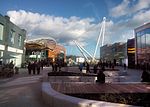Newport City footbridge
Bridges completed in 2006Bridges in Newport, WalesBridges over the River UskLandmarks in Newport, WalesPedestrian bridges in Wales ... and 1 more
Use British English from June 2013

Newport City footbridge is a pedestrian/cycle bridge over the River Usk in the city of Newport, South Wales. The bridge links the east bank of the river in the vicinity of Rodney Parade stadium to University Plaza on the west bank. It was the first major public project in Newport Unlimited's plans to regenerate the city. It won a British Constructional Steelwork Association award; the 2007 George Gibby Award from the Institution of Civil Engineers in Wales; a Royal Institution of Chartered Surveyors award for regeneration in Wales, and a highly commended from Wales Business Insider for their best regeneration project of 2007.
Excerpt from the Wikipedia article Newport City footbridge (License: CC BY-SA 3.0, Authors, Images).Newport City footbridge
Newport City footbridge, Newport Victoria
Geographical coordinates (GPS) Address Nearby Places Show on map
Geographical coordinates (GPS)
| Latitude | Longitude |
|---|---|
| N 51.58691 ° | E -2.990191 ° |
Address
Newport City footbridge
NP19 0BB Newport, Victoria
Wales, United Kingdom
Open on Google Maps










